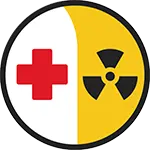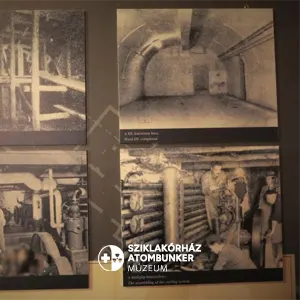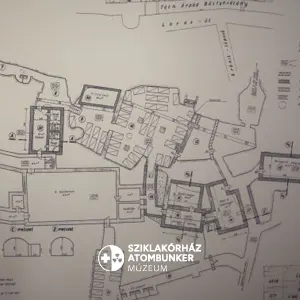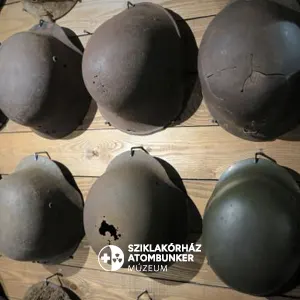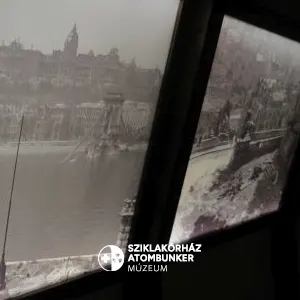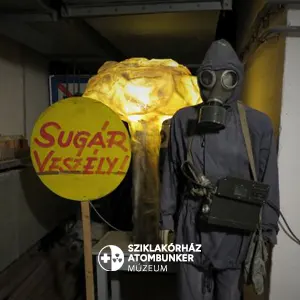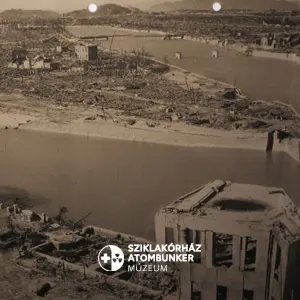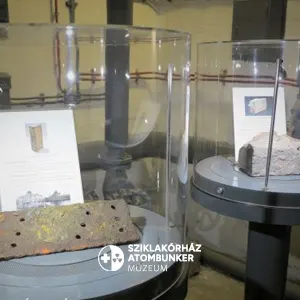THE HOSPITAL IN THE ROCK NUCLEAR BUNKER MUSEUM
The Hospital in the Rock Museum is located in the heart of Europe, under the Buda Castle. The hospital played an important historical role as an emergency facility both during World War II and during the 1956 revolution. It was developed into a nuclear bunker during the Cold War and was top secret until 2002.
The museum opened its doors in 2007 and for today more than 1,000,000 visitors has seen its exhibitions. Its mission is to show the true face of war and highlight the value of peace. It commemorates the everyday heroes who testified to their determination and heroism during the most difficult periods of the twentieth century. Its primary purpose is to preserve and present the eternal values they represent.
During the guided tours the tourguides will show the history of the more than 2,000-square-meter underground facility and all its exhibits in 60 minutes.
MEDICAL TOOLS AND INSTRUMENTS OF MILITARY MEDICINE (1940-1980)
How did medical tools change (or just didn’t change) from World War II to the fall of communism? In addition to familiar objects such as scalpels or syringes, in our medical tools history exhibition we will also be showcasing special instruments – including various lung staplers, a double-bladed bone saw or a tonometer.
A significant part of the exhibited objects is from the most basic of military medicine and surgery, but we also have objects from the fields of otolaryngology, dentistry and gynecology.
FRIEDRICH BORN MEMORIAL EXHIBITION
Friedrich Born, the delegate of the International Committee of the Red Cross in Hungary, saved the lives of more than 15,000 people during the Holocaust. He handed out letters of protection to the persecuted, he took care of hospitals and orphanages. In December 1944, he moved his headquarters to the Hospital in the Rock after his office and apartment were bombed. He declared the institution a Red Cross hospital, and he also helped to save lives by providing drug supplies. Our museum pays homage to his rescue activities with a memorial room.
AIR RAID ALARM CENTER (1937-45)
Starting from the summer of 1944, the sound of air raid sirens could be heard more and more frequently in Budapest. But who turned them on and where? Air Raid Alarm Center “K”, which was built out in the same cave system as the Hospital in the Rock, was one of the stations from which the members of the Civil Air Defense League spread the news of an upcoming attack. This is the earliest built part of the area of today’s museum, and between 1937 and 1945 the air raid sirens of the Castle District were operated from here.
In addition to the different means of communication, the exhibition also shows how civilians were prepared for air strikes.
LOCAL HISTORY EXHIBITION
“Wonder of Europe” – this is how the newspapers described the cave system in the depths of the Castle Hill in 1935. The section excavated at that time was presented to those interested as a natural attraction, but it soon turned out that the tourist sensation should rather be put at the service of saving lives. In preparation for the war, shelters were established in the caves, and in 1941 the construction of the Hospital in the Rock was started. Our exhibition shows how the underground construction was carried out, and it also explains how the facility was transformed into a nuclear safe building during the Cold War.
SIEGE OF BUDAPEST EXHIBITION
The exhibition, opened in 2016, evokes the besieged Budapest of 1944-45, showcasing the brutality of war, as well as humanity and the challenges of medical care. This imaginary attic illustrates the devastating ferocity of the fights around the capital with a large number of military relics. As a result of the battle that lasted for three months, Budapest was completely ruined and hundreds of thousands of people died. With the exhibition, we draw attention not only to the military losses of the fights, but also to the numerous victims among the civilian population.
SPECIAL OPERATIONS FORCES EXHIBITION
Special Operations Forces take care of their wounded in the most impossible places during their covert operations. Thanks to their special training, they can provide each other, and even themselves, with effective first aid care. In many cases, if they can’t act right away, they die. The history of the Hospital in the Rock is the history of saving lives, which, however, did not end in 1945 or 1956.
Although the goals and means are different, there still is a special professionalism and courage in today’s conflicts. With this exhibition, we commemorate the exemplary work of these anonymous heroes.
‘NOW I AM BECOME DEATH, THE DESTROYER OF WORLDS’ EXHIBITION
As a former atomic bunker, we wanted to show the effects of nuclear weapons and how the Hospital in the Rock would have been defended against them. Visitors can learn about the terrible devastation through images taken after the nuclear explosions over Hiroshima and Nagasaki and through replicas of original objects. This exhibition is housed in the facility’s machinery, where visitors can also see how the institution could have survived a nuclear attack, and how the medical treatment of survivors would have been carried out.








